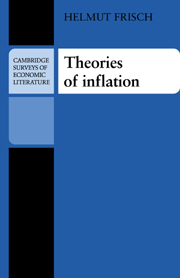Book contents
2 - Expectations and inflation
Published online by Cambridge University Press: 05 May 2010
Summary
One of the major differences between the theories of inflation developed in the last fifteen years and the traditional theories (as discussed in Chapter 7) is the role of inflationary expectations. Although Keynes, Hicks, Lange, and others have discussed expectations, only recently the formation of expectations has been extensively investigated by the current models of inflation. It is no exaggeration to say that this has raised the economic theory of expectations to a new and higher level.
The traditional concept of expectations in economic theory goes back to J.R. Hicks's (1946) treatment in his major work Value and Capital. Hicks discussed the concept of expectations in connection with his analysis of the stability of general economic equilibrium. Whether an equilibrium point is stable depends on how expectations change as a result of a shock to the system that shifts it away from equilibrium. In this context a central problem arises – namely, how to formulate the relationship between the change in expectations and the disturbance of the equilibrium. For this purpose Hicks used the concept of the elasticity of expectations, or the relationship between the percent change in the expected value of a variable and the percent change in the actual value of the same variable. In Hicks's words: “I define the elasticity of a particular person's expectations of the price of commodity X as the ratio of the proportional rise in the expected future prices of X to the proportional rise in its current price” (1946, p. 205).
- Type
- Chapter
- Information
- Theories of Inflation , pp. 20 - 29Publisher: Cambridge University PressPrint publication year: 1984

